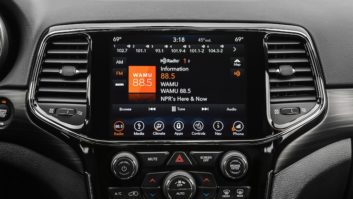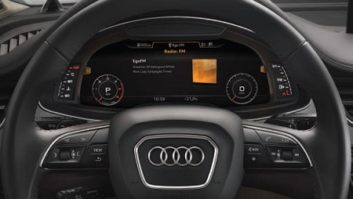What to do with HD Radio (Besides the Jukebox)
Jan 5, 2013 1:00 PM, By Doug Irwin, CPBE DRB AMD

If eight years ago (when HD Radio transmission facilities really started springing up around the country) you had asked “How will HD Radio fare in 2013?” the answer would likely have seemed more positive than what has, in fact, been achieved. We all know that. The multicast capability seemed like it was going to be the killer app, at least for a while. From the perspective of eight years away from the original installations, what can we say has been become the most important use of HD Radio capability? Even up to 10 or 12 years ago, the capacity to add another program channel — essentially a whole other radio station — would seem fantastic to many radio station programmers; however, we all know because of various circumstances (which I won’t address) that capability (which I will refer to as jukebox) is not a selling point for HD Radio. What, then, are other things you can do with an HD Radio facility?
Leasing the facility
Superficially at least, the HD Radio multicast capability would seem to be a natural extension of the kinds of services previously served with SCA; I’m unaware of any organization making that change successfully though. However, there are broadcast organizations that use HD Radio multicast capacity to extend their network footprints. More than two years after I first wrote about them. Hum Desi radio is still on the air in New York (though it has moved to 97.1 HD2 from 98.7 HD2). Hum Desi bills itself as “The largest south Asian radio network in North America” and is broadcast in at least four other large markets: Los Angeles, Chicago, San Francisco and Washington.
There has been a trend over the last five or so years for non-commercial FM stations to double-up in their communities, buying another station, with the intention of placing a music format on one station, and a news format on the other: WNYC and WQXR in New York come to mind as one example. Alternatively though, some stations have placed one format on their analog transmission, while putting the other on a digital multicast. WWFM (Mercer County Community College) in Trenton, NJ, is a perfect example of a broadcast organization making use of HD Radio multicast capability to extend its reach in this fashion. WWFM is the flagship station of “The Classical Network” that can be heard in the western part of New Jersey and the eastern part Pennsylvania. However, it has extended its coverage area beyond the range of its own facilities by leasing multicast space on other stations. “The Classical Network” can be heard on the HD2 channel of WKCR in New York, and WKVP in Philadelphia. WWFM also has a jazz format known as JazzOn2 heard on the HD2 channel of three of Mercer’s other stations: WWNJ, WWPJ and WWCJ (as well as the HD2 of WWFM). I have previously written about the methodology used by Mercer for distribution of their programs.
Northwest Public Radio (based at Washington State University in Pullman, WA) provides yet another example of this type of network distribution. Its network extends as far east as Lewiston, ID, and as far northwest as Forks, WA. Some of its main (analog) channels carry the news service, while the same station’s HD2 carries the classical service; some are the other way around, with classical on the main, and news on the HD2. Program distribution is via satellite; uplinking is in conjunction with Colorado Public Radio. The two program services are hauled between Pullman and Denver with T1 connectivity. Both are uplinked, and each NWPR site has a digital satellite receiver (from ICP) with local storage on-board, giving each site the ability to insert localized information, such as the station ID, and even local weather.
– continued on page 2
What to do with HD Radio (Besides the Jukebox)
Jan 5, 2013 1:00 PM, By Doug Irwin, CPBE DRB AMD
Feeding FM translators
Stories about the use of HD Radio to feed FM translators have been in the industry news for about the last five years. A letter from the FCC to ROI Broadcasting from May of 2010 clearly states the commission’s position on such use.
Probably the most interesting example of using HD Radio in this fashion is from Hochman Hawaii Media, in Honolulu. Hochman’s KORL-FM (101.1) uses its digital transmission capacity to feed three translators: K268BE (101.5); K246BR (97.1) and K298BA (107.5). All three are at the 250W level, with a HAAT of 1,680′. Each has a different music format. Additionally, its station KPHI (1130 KHz) now appears on translator K244EO, another 250W facility.
The topic of FM translators (how to get a C.P.; how to develop a site; and finally, how to license one) is a topic of its own, but it would not be wise for a station, on the outside chance that it might be able to translate a multicast program to an FM channel, to build an HD Radio facility based on that reason alone. That would truly be the tail wagging the dog.
Data transmission: the killer app?
If you look at HD Radio objectively you see it basically as a means to transmit data, and interestingly, where HD Radio seems to have won out is in its ability to disseminate data over a wide area (proportional to a stations power and coverage area obviously). Whereas the likes of Seiko (going back pretty far), Bonneville, and more recently Microsoft’s MSN Direct (all of which used SCA) have come and gone, HD Radio is gaining traction most effectively in data transmission. Let’s take a look at a couple of large organizations taking advantage of this capability.
The first one is the Broadcaster Traffic Consortium. The BTC is a group of 20 different broadcast companies, including Emmis, Entercom, Cox, Lincoln Financial Media, Beasley, Townsquare Media, NPR, and others. This joint venture is spearheaded by Paul Brenner, the CTO of Emmis Communications. The BTC’s stated mission is to unify the radio industry for the delivery of nationwide HD Radio data services; to improve HD Radio system standards; to lead industry regulation and policy to support the advancement of HD Radio transmission; and finally, to build business value for HD Radio.
– continued on page 3
What to do with HD Radio (Besides the Jukebox)
Jan 5, 2013 1:00 PM, By Doug Irwin, CPBE DRB AMD
The BTC system begins with the collection of data by a given source such as Navteq. The system is a TCP-based client-server model with SaaS (software as a service) capability, fulfilling the server function for providing the data source. Nokia is the data aggregator for highly advanced, automated services for location-based data and commerce, traffic, weather, and map-related services. It automates the data collection and formatting for RDS-TMC (Traffic Message Channel), HD/TMC and HD/TPEG; those messages are then sent via the public Internet to member stations for broadcast. The BTC and Nokia have collaborated to build capability into the HD Radio Importer so they can operate more efficiently and consistently on the station side of operations.

A Garmin GPS with HD Radio traffic data.
According to Brenner, “[The] BTC has performed proof of concept capability of HD Radio data services with e-reader companies and automakers (independent of our efforts with Nokia). FM/HD broadcasting is a highly efficient and economical solution for delivering mass-market data to high volumes of consumer devices. We continue to look for opportunities to make HD Radio data services a business solution where perhaps, satellite or mobile broadband were the only two considerations.”
The other large traffic distribution service is Total Traffic Network (which is a subsidiary of Clear Channel Media and Entertainment). TTN services more than 100 markets in the United States, Canada and Mexico, providing traffic data to more than 3,000 radio stations, in addition to 200 television affiliates.
The traffic information comes from 20+ local operations offices; the operations staff is trained in traffic data aggregation and use a combination of resources including (but not limited to) real-time flow data from several partners, DOT cameras and sensors, Aerial and Mobile traffic spotters, proprietary cameras, social media and traffic Tip Lines. All of that information is entered into TTN’s software platform called TrafficNet. TrafficNet can be accessed via the Internet from any location, and has the ability to sort and filter the information by type, time, region and severity. This information can be classified primarily in two categories: flow alert data and speed data. Flow alert data typically defines an average speed across a linear segment of TMC locations in a particular direction at a given time. Speed data typically defines an average speed found at a single TMC location at a given time. TrafficNet collects congestion data from providers, translates the data into a common data schema, aggregates it temporally, spatially, and finally, generates a flow alert feed ready to be consumed by various applications.
TrafficNet is, however, independent from the distribution means inside of Clear Channel. Servers at the CC facility in Cincinnati pull data from TrafficNet, format it for RDS-TMC, HD/TMC, as well as HD/TPEG, and send it to the targeted stations via the CC WAN. Once the messages arrive at a studio facility, they’re forwarded over the LAN to the appropriate RDS encoders, and/or HD Radio importers.
HD-TMC gives stations a huge increase in the number of messages that can be transmitted with respect to RDS-TMC. TPEG messages allow for even greater granularity than TMC messages.
– continued on page 4
What to do with HD Radio (Besides the Jukebox)
Jan 5, 2013 1:00 PM, By Doug Irwin, CPBE DRB AMD
HD Radio-based traffic information
You may ask, “Are there receivers in the field that use this data?” The answer is yes. Garmin’s Nuvi 3490 features Garmin Guidance 3.0, which gets its data via HD Radio. Kenwood makes at least two different units: the DNX6190HD and the DNX9990HD. JVC makes at least three after-market HD Radio receivers that receive and interpret traffic info: models KW-NT3HDT, KW-NT500HDT, and KW-NT800HDT. A company called Cydle offers its T43H with GPS and traffic supplied via HD Radio. Pioneer offers the AVIC-Z140BH.
The 2014 Outlander from Mitsubishi will be the first vehicle to have real-time traffic information integrated into its navigation system. This was just announced at the 2012 Los Angeles Auto Show.
It would be unrealistic to judge the success or failure of HD Radio simply based on the jukebox capability, which hasn’t resonated with listeners — at least not yet. However, as you have read, there are other, less-well-known facets of HD Radio that make it viable. If you work for a station that is still on-the-fence with respect to HD Radio, I urge you to consider all of its capabilities while making your decision.
Irwin is transmission systems supervisor for Clear Channel NYC and chief engineer of WKTU, New York. Contact him at [email protected].
WorldBand Media Delivers on HD2
The format delivered by WRKS’s HD2 stream is known as HumDesi Radio, and according to their website, HumDesi radio is the largest south Asian radio network….
What’s New in Program Distribution?
Several case studies examine the current trends in distribution via IP links….
January 2013
The studios of JENNiRADIO, making HD Radio more than just a jukebox, testing antennas with a network analyzer, and Field Reports on the Tieline Report-IT and Deva Broadcast SmartGen Mini….









